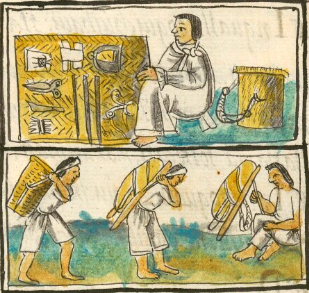tlamamalli (FCbk10f29v)
This iconographic example, features three loads or burdens (tlamamalli), bundles that were to be carried by human carriers on their backs with a tumpline (mecapalli) across the forehead. This example is included in this digital collection for the purpose of making comparisons with related hieroglyphs. The term selected for this example comes from the keywords chosen by the team behind the Digital Florentine Codex. There is no gloss or textual sample. This example shows two men in profile moving toward the viewer’s right with loads on their backs. The one on the far left has something like a large basket connected to his tumpline. He wears a white cotton short-sleeve shirt and knee-length pants, clothing that shows Spanish colonial influence, as does the shading and three-dimensionality of the cloth. He grabs the tumpline with both hands, behind his head, so that it would not slip off. He is barefooted. The next man who is also on his feet carries a tlamamalli that is tied with a rope to a wooden frame (probably a cacaxtli) on his back. He is dressed the same. A third man, on the viewer’s right, sits by a bundle (tlamamalli) that is attached to the wooden frame. He faces the men who are coming toward him. He sits with his forelegs almost crossed, which differs from the older way of sitting with the two knees up under the chin. He grabs onto what is probably a cacaxtli, a wooden frame. In particular, he grasps the leg that helps the frame stand on its own when it is not on a person’s back. While the other two tumplines (what would be called mecapalli) are plain white, this one show that it is woven, something like a petlatl (woven mat).
Stephanie Wood
The tlamamalli can be a wrapped bundle tied to a frame or a load of material that is stored in a basket. Either way, the verb is tlamama, to carry something, and to do so by means of a tumpline, one can say ixcuamama, as indicated by the keywording team of the DFC.
Stephanie Wood
1577
Jeff Haskett-Wood
mecapal, mecapales, mecapalli, cacaxtli, cacax, bultos, cargas, transporte, cargar, tecnología, atado, soga, sogas, tlamama, ixcuamama, tameme
tlamamal(li), a burden, a load for a human carrier, https://nahuatl.wired-humanities.org/content/tlamamalli
bultos para tamemes
Stephanie Wood
Available at Digital Florentine Codex/Códice Florentino Digital, edited by Kim N. Richter and Alicia Maria Houtrouw, "Book 10: The People", fol. 29v, Getty Research Institute, 2023. https://florentinecodex.getty.edu/en/book/10/folio/29v/images/0 Accessed 10 September 2025.
Images of the digitized Florentine Codex are made available under the following Creative Commons license: CC BY-NC-ND (Attribution-NonCommercial-NoDerivs 4.0 International). For print-publication quality photos, please contact the Biblioteca Medicea Laurenziana ([email protected]). The Library of Congress has also published this manuscript, using the images of the World Digital Library copy. “The Library of Congress is unaware of any copyright or other restrictions in the World Digital Library Collection. Absent any such restrictions, these materials are free to use and reuse.”


